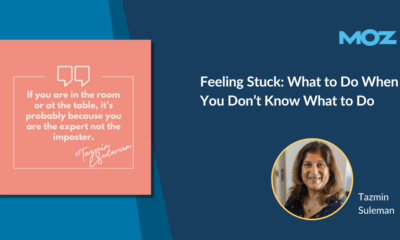SOCIAL
Effective Ways To Personalize Your Customer Touch Points Even More In 2023

Personalization
Will 2023 be the year of personalization? Consumers hope so. For the past two years, shoppers have been craving the personal touch: In 2021, McKinsey & Company noted that 71% of customers expected companies to deliver personalization. In 2022, a Salesforce survey found that 73% of people expected brands to understand their needs and expectations. So, this year is looking like one where personalization can no longer be seen as a “nice to have.”
The problem, of course, is how to get more personalized. Many companies have already started to dabble in this. They greet shoppers by name on landing pages. They rely on CRMs and other tools to use historical information to send shoppers customized recommendations. They offer personalized, real-time discounts to help buyers convert their abandoned shopping cart items to actual purchases.
These are all great ideas. The only problem is that they’ve become widespread. They don’t move the needle on the customer experience anymore. Instead, they’re standard, expected, and kind of forgettable. That doesn’t mean you can afford to stop doing them. It just means you must devise other ways to pepper personalization throughout your consumer interactions.
If you are scratching your head on how to outdo 2022’s personalization in 2023, try implementing the following strategies:
1. Go for full-blown engagement on social media.
One easy way to give the personal touch is through your social media business pages. Social media use just keeps growing. In 2022, there were about 266 million monthly active users (or MUAs) on Facebook, one billion on Instagram, and 755 million on TikTok. Not all these active users will fall into your target audiences, but plenty of them will.
Make engaging with your social followers one of this year’s goals. People spend a lot of time on social media. It’s where many of them “live,” so it only makes sense that it should be a place to drive personalization.
One quick way to ratchet up your company’s personal touch on social media is to personalize all your retargeted ads. Quizzes can also offer a chance for personalization. Simply set up an engaging quiz and allow people to share their results. It’s a fun way to build brand recognition and bond with consumers. Of course, there’s nothing wrong with going very personal and answering all comments. Depending on your team’s size and the number of comments you receive, this might be a viable option.
2. Leverage AI to go beyond basic demographics.
Most companies rely on customer demographic information to bolster personalization efforts. The only trouble with this tactic is that demographics can’t tell the whole story. It’s impossible to get a lot of context about individual users (such as their lifestyles, personal preferences, and motivators) just from knowing their age, gender, or location. Though demographic data is beneficial, it can cause some significant misses.
Michael Scharff, CEO and cofounder of Evolv AI, explains the workaround for this problem: “The most natural, and therefore productive, personalization efforts use demographics as a foundation and then layer in user likes, dislikes, behaviors, and values.”
You can leverage AI’s predictive and insightful capabilities to uncover real-time user insights. Scharff recommends this technique because it allows you to stay in sync with the fast-moving pace of consumer behavior changes. He adds that AI can be particularly beneficial with the coming limits to third-party cookie access because it can be a first-party data source, allowing you to maintain customer knowledge and connection.
To flesh out your organization’s strategy, look to other companies that have gone beyond demographics. Take Netflix, for example, which constantly tweaks its AI algorithm to help improve personalized content recommendations. Bottom line? Going deeper than surface information makes all the sense in the world if you want to show customers you know them well.
3. Keep your data spotless.
The better your data, the better your personalization efforts. Period. Unfortunately, you are probably sitting on a lot of unstructured or otherwise tricky-to-use (or impossible-to-use) data. One recent Great Expectations survey revealed that 77% of data practitioners have data quality problems, and 91% say that this is wreaking havoc on their companies’ performance.
You can’t personalize anything with corrupt or questionable data. So, do your best to find ways to clean your data promptly and routinely. For example, you might want to invest in a more centralized data system, particularly if the personalization data you rely on is scattered in various places. Having one repository of data truth makes it easier to know if the information on hand is ready to use.
Another way to tame your data is to automate as many data processes as possible. Reducing manual manipulation of data lessens the chance of human error. And you’ll feel more confident with all your personalization efforts if you can trust the reliability and health of your data.
4. Go for nontechnical personalization.
It’s the digital age, but that doesn’t mean every touchpoint has to be digitized. Consumers often react with delight and positivity when they receive personalization in decidedly nontech forms. (Yes, you can use tech to keep track of everything. Just don’t make it part of the actual personalized exchange!)
Consider writing handwritten thank-you notes to customers after they’ve called in for support or emailed your team, for instance. Or send an extra personalized gift to buyers who make a specific number of purchases. These interactions aren’t technical but can differentiate your customer experience from your competitors’ experiences.
A groundbreaking Deloitte snapshot taken right before the pandemic showed that people were hungry for connection. By folding nondigital experiences into your personalization with customers, you’re showing them that you see them first as valued humans. That’s compelling and appealing, making them more apt to give you their loyalty in return.
Putting a personal spin on all your consumer interactions takes a little time. It’s worth your energy, though. You’ll wind up with stronger brand-buyer connections, helping you edge ahead of your competitors even more.
SOCIAL
Snapchat Explores New Messaging Retention Feature: A Game-Changer or Risky Move?

In a recent announcement, Snapchat revealed a groundbreaking update that challenges its traditional design ethos. The platform is experimenting with an option that allows users to defy the 24-hour auto-delete rule, a feature synonymous with Snapchat’s ephemeral messaging model.
The proposed change aims to introduce a “Never delete” option in messaging retention settings, aligning Snapchat more closely with conventional messaging apps. While this move may blur Snapchat’s distinctive selling point, Snap appears convinced of its necessity.
According to Snap, the decision stems from user feedback and a commitment to innovation based on user needs. The company aims to provide greater flexibility and control over conversations, catering to the preferences of its community.
Currently undergoing trials in select markets, the new feature empowers users to adjust retention settings on a conversation-by-conversation basis. Flexibility remains paramount, with participants able to modify settings within chats and receive in-chat notifications to ensure transparency.
Snapchat underscores that the default auto-delete feature will persist, reinforcing its design philosophy centered on ephemerality. However, with the app gaining traction as a primary messaging platform, the option offers users a means to preserve longer chat histories.
The update marks a pivotal moment for Snapchat, renowned for its disappearing message premise, especially popular among younger demographics. Retaining this focus has been pivotal to Snapchat’s identity, but the shift suggests a broader strategy aimed at diversifying its user base.
This strategy may appeal particularly to older demographics, potentially extending Snapchat’s relevance as users age. By emulating features of conventional messaging platforms, Snapchat seeks to enhance its appeal and broaden its reach.
Yet, the introduction of message retention poses questions about Snapchat’s uniqueness. While addressing user demands, the risk of diluting Snapchat’s distinctiveness looms large.
As Snapchat ventures into uncharted territory, the outcome of this experiment remains uncertain. Will message retention propel Snapchat to new heights, or will it compromise the platform’s uniqueness?
Only time will tell.
SOCIAL
Catering to specific audience boosts your business, says accountant turned coach

While it is tempting to try to appeal to a broad audience, the founder of alcohol-free coaching service Just the Tonic, Sandra Parker, believes the best thing you can do for your business is focus on your niche. Here’s how she did just that.
When running a business, reaching out to as many clients as possible can be tempting. But it also risks making your marketing “too generic,” warns Sandra Parker, the founder of Just The Tonic Coaching.
“From the very start of my business, I knew exactly who I could help and who I couldn’t,” Parker told My Biggest Lessons.
Parker struggled with alcohol dependence as a young professional. Today, her business targets high-achieving individuals who face challenges similar to those she had early in her career.
“I understand their frustrations, I understand their fears, and I understand their coping mechanisms and the stories they’re telling themselves,” Parker said. “Because of that, I’m able to market very effectively, to speak in a language that they understand, and am able to reach them.”Â
“I believe that it’s really important that you know exactly who your customer or your client is, and you target them, and you resist the temptation to make your marketing too generic to try and reach everyone,” she explained.
“If you speak specifically to your target clients, you will reach them, and I believe that’s the way that you’re going to be more successful.
Watch the video for more of Sandra Parker’s biggest lessons.
SOCIAL
Instagram Tests Live-Stream Games to Enhance Engagement

Instagram’s testing out some new options to help spice up your live-streams in the app, with some live broadcasters now able to select a game that they can play with viewers in-stream.
As you can see in these example screens, posted by Ahmed Ghanem, some creators now have the option to play either “This or That”, a question and answer prompt that you can share with your viewers, or “Trivia”, to generate more engagement within your IG live-streams.
That could be a simple way to spark more conversation and interaction, which could then lead into further engagement opportunities from your live audience.
Meta’s been exploring more ways to make live-streaming a bigger consideration for IG creators, with a view to live-streams potentially catching on with more users.
That includes the gradual expansion of its “Stars” live-stream donation program, giving more creators in more regions a means to accept donations from live-stream viewers, while back in December, Instagram also added some new options to make it easier to go live using third-party tools via desktop PCs.
Live streaming has been a major shift in China, where shopping live-streams, in particular, have led to massive opportunities for streaming platforms. They haven’t caught on in the same way in Western regions, but as TikTok and YouTube look to push live-stream adoption, there is still a chance that they will become a much bigger element in future.
Which is why IG is also trying to stay in touch, and add more ways for its creators to engage via streams. Live-stream games is another element within this, which could make this a better community-building, and potentially sales-driving option.
We’ve asked Instagram for more information on this test, and we’ll update this post if/when we hear back.
-

 WORDPRESS7 days ago
WORDPRESS7 days ago10 WordPress Influencers to Follow in 2024 – WordPress.com News
-

 MARKETING7 days ago
MARKETING7 days agoFeeling Stuck: What to Do When You Don’t Know What to Do
-

 PPC6 days ago
PPC6 days agoCompetitor Monitoring: 7 ways to keep watch on the competition
-

 PPC5 days ago
PPC5 days agoA History of Google AdWords and Google Ads: Revolutionizing Digital Advertising & Marketing Since 2000
-

 WORDPRESS6 days ago
WORDPRESS6 days agoThrive Architect vs Divi vs Elementor
-

 SEARCHENGINES6 days ago
SEARCHENGINES6 days agoMore Google March 2024 Core Update Ranking Volatility
-

 PPC6 days ago
PPC6 days ago31 Ready-to-Go Mother’s Day Messages for Social Media, Email, & More
-

 WORDPRESS5 days ago
WORDPRESS5 days agoTurkish startup ikas attracts $20M for its e-commerce platform designed for small businesses











You must be logged in to post a comment Login